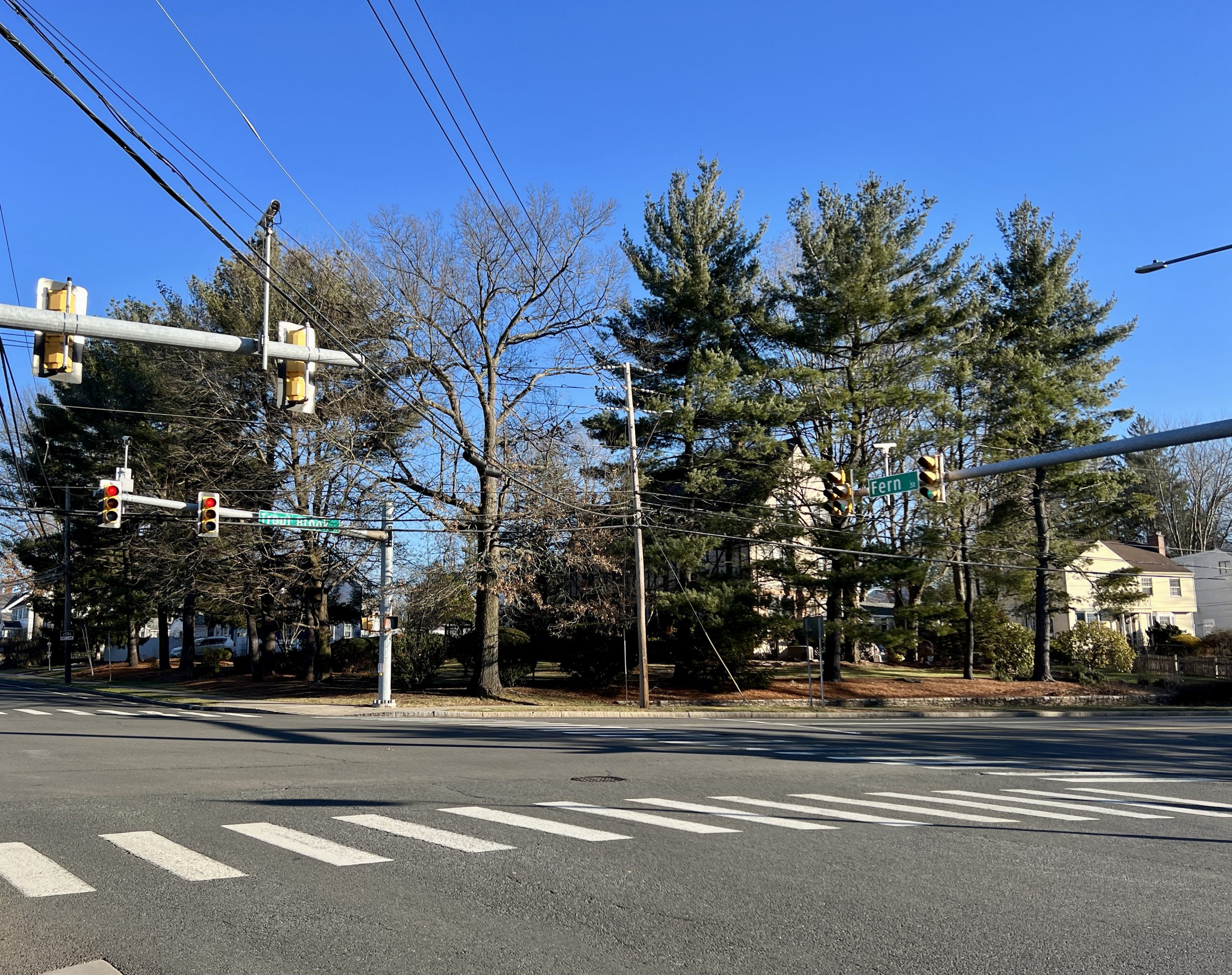Op-Ed: West Hartford’s Residents Have Been Struggling for Safer Streets for 50 Years

Audio By Carbonatix

Intersection of Fern Street and Trout Brook Drive. Photo credit: Ronni Newton
In the early 1970s, a group of mothers of students at Morley School pushed for a safer crossing at the intersection of Fern Street and Trout Brook Drive.
By Thomas Broderick
In December 2022 West Hartford became the epicenter of the safe streets movement in Connecticut, with three pedestrian crashes in five days, including two pedestrians killed on Dec. 20 and 21. These awful tragedies marked a dangerous year in the town, with 15 people hit by drivers. Local residents and advocates have responded, publishing op-eds calling for safer streets and holding a rally demanding safer streets for all. But the struggle for pedestrian safety in West Hartford goes back much further, and the failures of 50 years ago show us that this time around we must demand lasting, durable changes to the built environment.
In 1971 a group of so-called “Morley Moms,” the mothers of students who attended Edward W. Morley School, planned to blockade Trout Brook Drive if the Town of West Hartford didn’t make it safer for their children to walk to school. According to a Feb 11, 1971 article in the Hartford Courant titled “Blockade is Planned by Morley Mothers,” their demands were remarkably simple – unless West Hartford agreed to assign a crossing guard to the intersection at Trout Brook Drive and Fern Street, a group of mothers would blockade the road. There were 174 children who walked to school along this route every day, and the mothers told the Courant that the new walk lights at the intersection were inadequate protection given the sharp increase in traffic.
These mothers were taking part in a little-known (at least today) movement that became wide-spread in the United States in the 1950s and 1960s: baby carriage blockades. As University of Virginia historian Peter Norton wrote in a medium post and described in the excellent new documentary “The Street Project,” these protests featured women and children blocking streets to protest traffic violence. The name “baby carriage blockade” came from the fact that women often brought baby carriages with them to emphasize the connection to motherhood and children’s safety. The “Morley Moms” were bringing a version of the movement to Connecticut.
West Hartford’s official reaction in 1971 is instructive for 2023. Then-Police Chief William P. Rush rejected the request for a single crossing guard, while then-Mayor Ellsworth Grant said there was nothing he could do. The Town Council, meanwhile, recommended its Traffic Study Committee examine the matter. Incredibly, although he eventually recommended a crossing guard be assigned, the town manager warned that “assigning the guard could establish an expensive precedent. Parents could demand guards for other intersections with walk lights.” In other words, in 1971 West Hartford worried that if they addressed one clearly unsafe intersection, they might have to address them all – and that, they felt, would be unsustainable.
A quick Google Maps street view of Fern and Trout Brook shows an intersection with five lanes, curved curbs to increase car speed around corners, and right lanes for turning traffic. In short, the Morley Moms may have gotten a crossing guard for the intersection, but street design that prioritized car flow and speed remained in the long-term. This is a key lesson for advocates today – we need durable, lasting changes to the built environment.
Flash forward to 2023 and West Hartford has once again tasked a committee with addressing pedestrian safety. More tangibly, on Jan. 11 the West Hartford Town Council unanimously adopted a Vision Zero initiative, calling for a “proactive plan to make roadways safer for all users.” Hopefully these studies and proclamations will produce more lasting results than they did in 1971 (the street redesign plans leave me cautiously optimistic).
The struggle for pedestrian safety in West Hartford is not just a local issue. Those of us hoping for systemic roadway changes across the state are looking to its advocates and their efforts. A successful outcome must involve the second action item in Bike West Hartford’s open letter, which calls for traffic-calming infrastructure at high-crash locations. Until local towns, cities, and the Department of Transportation make actual changes to roads, the state’s record-setting 76 pedestrian deaths in 2022 will continue.
The Jan. 30 Vision Zero (known as HB 5917) hearing in the Transportation Committee – and the overwhelmingly supportive written testimony that accompanied it – are signs that the status quo may be changing, albeit slowly. If you have not already, reach out to your state Senator and Representative and urge them to support it.
Streets safe enough for children to walk to school are streets that are safe enough for everyone. West Hartford’s citizens are demanding safer streets, a demand that goes back more than 50 years. We know how to make roads for pedestrians and bikers, and we don’t have to accept traffic violence as part of modern life. Support West Hartford and demand that your own local officials end traffic violence.
Thomas Broderick is a Connecticut educator and liveable streets and housing advocate. He loves history, hiking, and sampling every craft beer he can find across the state.
We-Ha.com will accept Op-Ed submissions from members of the community. We reserve the right to edit all submitted content.
Like what you see here? Click here to subscribe to We-Ha’s newsletter so you’ll always be in the know about what’s happening in West Hartford! Click the blue button below to become a supporter of We-Ha.com and our efforts to continue producing quality journalism.




strongly agree with
“Streets safe enough for children to walk to school are streets that are safe enough for everyone.”
Thank you so much for writing this!! It was very insightful. I believe in our ability to make our town better and safer. Traffic calming works. We need to redesign the streets to slow down traffic to less life-threatening speeds. I’m not sure drivers understand how unnecessary and intimidating it is to fly by pedestrians going 40 mph on residential streets or down busy parts of South Main. I think the streets need to be redesigned so that the comfortable speed is closer to 20 mph on residential streets and 25-30 on main streets except 44.
This provides some great and valuable insights into the history of how long this issue has been occurring in West Hartford. It is truly a shame that short sighted view that many take is that it is a pedestrians responsibility to not be run over by cars. I hope the town can now take some time to view that the streets of West Hartford can be made safer by encouraging less cars and more people centric transit design. Transit, housing and commerce are all intertwined matters that the town can take steps now to address in a forward thinking plan.